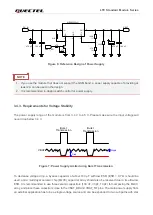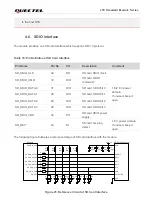
LTE Standard Module Series
Module
USIM_VDD
USIM_GND
USIM_RST
USIM_CLK
USIM_DATA
0R
0R
0R
100 nF
GND
33 pF 33 pF 33 pF
VCC
RST
CLK
IO
VPP
GND
GND
15K
USIM_VDD
(U)SIM Card Connector
Figure 20: Reference Circuit of (U)SIM Interface with a 6-pin (U)SIM Card Connector
In order to enhance the reliability and availability of the (U)SIM card in applications, please follow the
criteria below in (U)SIM circuit design.
⚫
Keep (U)SIM card connector as close as possible to the module. Keep the trace length as less than
200 mm as possible.
⚫
Keep (U)SIM card signal traces away from RF and VCC traces.
⚫
USIM_VDD maximum bypass capacitor does not exceed 1uF.
⚫
Ensure the ground between the module and the (U)SIM card connector short and wide. Keep the
trace width of ground and USIM_VDD no less than 0.5 mm to maintain the same electric potential.
⚫
To avoid cross-talk between USIM_DATA and USIM_CLK, keep them away from each other and
shield them with ground surrounded.
⚫
In order to offer good ESD protection, it is recommended to add a TVS diode array whose parasitic
capacitance should not be more than 15 pF. The 0
Ω
resistors should be added in series between the
module and the (U)SIM card to facilitate debugging. The 33 pF capacitors on the USIM_DATA,
USIM_CLK and USIM_RST trances are used for filtering interference. Please note that the (U)SIM
peripheral circuit should be close to the (U)SIM card connector.
⚫
The pull-up resistor on USIM_DATA can improve anti-jamming capability of the (U)SIM card. If the
(U)SIM card traces are too long, or the interference source is relatively close, it is recommended to
add a pull-up resistor near the (U)SIM card connector.
4.4. PCM and I2C Interface
The module provides one Pulse Code Modulation (PCM) digital interface for audio design, which supports
the primary mode (short frame synchronization) and the module works as both master and slave.
The module can only be used as primary devices in applications related to I2C interfaces.






























